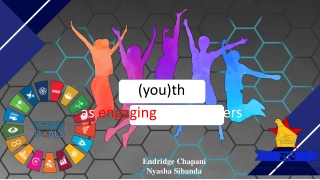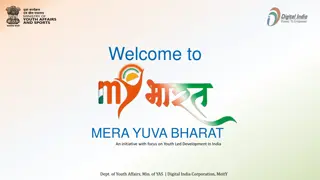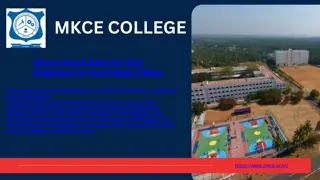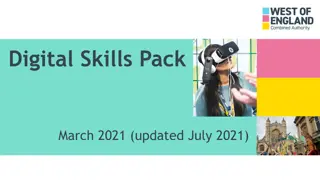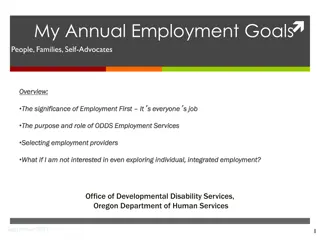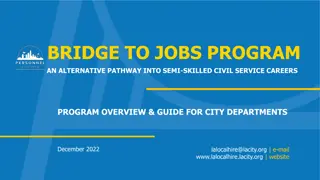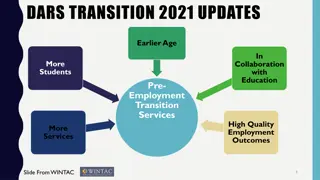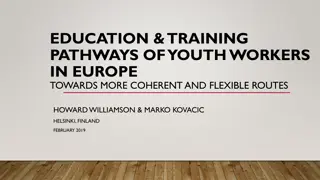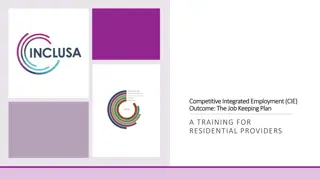Digital Skills: Youth Employment and Pathway to Future Jobs
Digital Skills for Students is a program aiming to bridge the gap between emerging technologies and the future job market. Through a comprehensive roadmap that includes foundational IT knowledge, non-technical skills, apprenticeships, and online courses, students are prepared for the evolving demands of the digital age. The program offers hands-on training, collaboration with industry partners, and pathways for talent development in higher education and beyond. With the increasing need for new skills and digital transformation in companies, this initiative equips individuals with the necessary tools to thrive in the ever-changing landscape of the workforce.
Download Presentation

Please find below an Image/Link to download the presentation.
The content on the website is provided AS IS for your information and personal use only. It may not be sold, licensed, or shared on other websites without obtaining consent from the author.If you encounter any issues during the download, it is possible that the publisher has removed the file from their server.
You are allowed to download the files provided on this website for personal or commercial use, subject to the condition that they are used lawfully. All files are the property of their respective owners.
The content on the website is provided AS IS for your information and personal use only. It may not be sold, licensed, or shared on other websites without obtaining consent from the author.
E N D
Presentation Transcript
Outline Introduction Cloud Computing Examples 2
Evolution Classical Computing Buy & Own Hardware, System Software, Applications often to meet peak needs. Install, Configure, Test, Verify Manage .. Finally, use it $$$$....$(High CapEx) Cloud Computing Subscribe Use $ - pay for what you use, based on QoS 3
Definition (1) Cloud Computing The Cloud is the default symbol of the Internet in diagrams. The broader term of Computing encompasses: - Computation - Coordination logic - Storage Cloud Computing is about moving computing from the single desktop pc/data centers to commercial service providers on the Internet. 4
Definition (2) Cloud Computing: Internet-based computing, whereby shared resources, software and information are provided to computers and other devices on- demand. Numerous previous attempts: on-demand computing, utility computing, ubiquitous computing, autonomic computing, platform computing, edge computing, elastic computing, grid computing, 5
Cloud characteristics Uses Internet technologies to offer scalable and elastic services. The term elastic computing refers to the ability of dynamically acquiring computing resources and supporting a variable workload. The resources used for these services can be metered and the users can be charged only for the resources they used. The maintenance and security are ensured by service providers. The service providers can operate more efficiently due to specialization and centralization. 6
Cloud Service Models Office Applications, CRM, E-mail, SaaS Media, Gaming Applications & Services SalesForce.com Google Docs Development Platforms, Runtime environments for applications, APIs PaaS Heroku Development Platform Microsoft Azure Virtual servers, virtual storage, and IaaS networking Amazon EC2, S3 Joyent, Rightscale Infrastructure 7
Types of clouds Public Cloud - the infrastructure is made available to the general public or a large industry group and is owned by the organization selling cloud services. Private Cloud the infrastructure is operated solely for an organization. Community Cloud - the infrastructure is shared by several organizations and supports a community that has shared concerns. Hybrid Cloud - composition of two or more clouds (public, private, or community) as unique entities but bound by standardized technology that enables data and application portability. 8
Cloud supporting technologies Cloud applications: data-intensive, compute-intensive, storage-intensive Bandwidth WS Services interface Web-services, SOA, WS standards VM0 VM1 VMn Virtualization: bare metal, hypervisor. Storage Models: S3, BigTable, BlobStore, ... Multi-core architectures 64-bit processor 9
Virtual machine monitor (VMM / hypervisor) Is the software that partitions the resources of computer system into one or more virtual machines (VMs). Allows several operating systems to run concurrently on a single hardware platform. A VMM allows Multiple services to share the same platform. Live migration - the movement of a server from one platform to another. Enforces isolation among the systems, thus security. 10
Virtual machines (VMs) VM - isolated environment that appears to be a whole computer, but actually only has access to a portion of the computer resources. Two VM Types: Process VM - a virtual platform created for an individual process and destroyed once the process terminates. System VM - supports an operating system together with many user processes (eg. Java Virtual Machine JVM). 11
Provisioning of virtual resources Cloud systems provide virtualized resources as a service VM Manager Submission Control Monitoring 12
Cloud Applications Scientific/Tech Applications Business Applications Customer/Social Applications Science and Technical Applications Business Applications 13 Customer/Social Applications
Windows Azure Enterprise-level on-demand capacity builder Computational cycles and storage available on-request for a cost You have to use Azure API to work with the infrastructure offered by Microsoft Significant features: web role, worker role , blob storage, table and drive-storage 14
Amazon web services (AWS) Provision of multiple service models: IaaS: EC2, S3, ELB, AutoScaler PaaS: Elastic Beanstalk, EMR SaaS: CloudSearch, Elastic Transcoder 15
Amazon Elastic Compute Cloud (EC2) A web service for instantiating computing instances with any of the operating systems supported. Features: Cloud Management Console, MapReduce Cloud, Cloud monitoring tools 16
EC2 pricing Ratio to Small Compute Unit/ Core U$ per hour Compute Units Virtual Cores Memory (GB) Disk (GB) Addr. (bits) Type 0,115 0,230 0,460 0,920 0,680 5,9 1,360 14,1 2,720 28,2 0,230 0,920 1 2 4 8 1 2 4 8 1 1 2 4 2 4 8 2 8 1 2 2 2 1,7 3,75 7,5 15 1690 17,1 34,2 68,4 1690 1,7 7 1690 160 32/64 410 32/64 850 Standard Small Standard Medium 64 64 64 64 64 Standard Large Standard Extra Large 6,5 13 26 3,25 3,25 3,25 2,5 2,5 420 850 High-Memory Extra Large High-Memory Double Extra Large High-Memory Quadruple Extra Large 2 8 5 350 32/64 High-CPU Medium 20 64 High-CPU Extra Large Cluster QuadrupleCloud Management Console, MapReduce Cloud, Amazon Machine Image (AMI) Extra Large --- --- 15,3 28,2 33,5 88 16 32 2,09 2,75 23 1690 60,5 1690 64 64 Eight Extra Large 17
Resources An Introduction to Virtualization and Cloud Technologies to Support Grid Computing, Ignacio M. Llorente Cloud Computing: Concepts, Technologies and Business Implications, B. Ramamurthy & K. Madurai Introduction to Cloud Computing, Dr. Rodrigo Calheiros ~OKEANOS presentation at cloudforum 2013, Nectarios Koziris, GRNET Cloud Computing Theory and Practice, Dan C. Marinescu 19
Questions? 20


